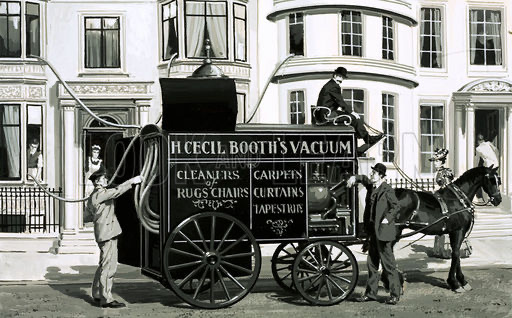
Contents
"Our portable engine and air compressor mounted on a strong truck arrives at your residence or other building to be cleaned in the morning. A small hose is run into the house, the tools are coupled up, which compresses some 75 feet of free pure outdoor air per minute at a high pressure which is conveyed through our patented tools to the articles to be cleaned. Nothing is taken from the premises. Carpets are cleaned right on the floor where they belong"
These words by John S. Thurman, are taken from a newspaper advert in 1899, advertising what is believed to be the first door-to-door carpet cleaning service. Thurman’s machine was transported by horse-drawn cart, and rather than extracting dust and soil into a machine, merely blew dust into a receptacle.
Thurman's invention was to prove the catalyst to the first commercial suction cleaner, deveoped by Hubert Cecil Booth.
After watching a demonstration of Thurman's device blowing dust off chairs, Booth thought that "...if the system could be reversed, and a filter inserted between the suction apparatus and the outside air, whereby the dust would be retained in a receptacle, the real solution of the hygienic removal of dust would be obtained."
And so he tested the idea by laying a handkerchief on the seat of a restaurant chair, putting his mouth to the handkerchief, and then trying to suck up as much dust as he could onto the handkerchief. Upon seeing the dust and dirt collected on the underside of the handkerchief, he realized the idea could work.
Booth proceeded to create a large cleaning machine, driven by an internal combustion engine. Nicknamed the "Puffing Billy", Booth's first petrol-powered, horse-drawn vacuum cleaner relied upon air drawn by a piston pump through a cloth filter.
The cleaning process didn't involve any form of carpet cleaning chemicals or agitation (the machine didn't contain any brushes) - all the cleaning was done by suction through long tubes with nozzles on the ends.
The machine would often be seen parked outside of businesses or homes that were being cleaned, with the hose running through the windows of buildings to where the carpet was to be cleaned. And although the machine was too bulky to be brought into a home or business, its principles of operation were essentially the same as the vacuum and carpet cleaning machines of today.
Indeed, while difficult to manoeuvre, these vacuum cleaning machines were quite sophisticated compared to what came before.
In the early 19th century, carpets were seen as a fashion statement and very much the preserve of the wealthy.
But cleaning them effectively was a difficult task left to household servants who would sweep up dust, soils and soot with a dustpan and brush.
As you can imagine, the majority of the soot and fine particles of dirt would simply be released into the air and settle back into the carpet fibres.
In addition to using a dustpan and brush, homeowners would protect their carpet from stains by covering it with draggets, which were thick fabrics that acted as a barrier between spillages and a carpet. These would most often be used around dining tables and seating areas in order to catch crumbs.
As carpets became more desirable and accessible, people searched for new ways of cleaning them effectively, with the infamous beating technique now being widely used. This involved hanging carpets up outside and vigorously beating them to remove the dust and soils; quite a heavy task for a housewife with a large carpet!
By the 1830’s housewives were using household recipes to treat carpet stains.
One such method was to scrub the carpet with lemon juice and hot loaves after it had been swept by broom.
After the carpet had been subjected to this crude treatment, they would give the carpet a rinse using cold water before hanging it up outside to dry on a sunny day.
In 1869, Ives W. McGaffey was granted a U.S. Patent for an IMPROVED SWEEPING-MACHINE.
The patent was granted device for the first device for cleaning rugs. While not motorised or electric, it is known as the first hand-pumped vacuum cleaner in the United States.
He called his machine “Whirlwind”.
While a big step forward, the name didn't quite live up to its billing, because "Whirlwind" was difficult to use and required the operator to manually turn a crank while pushing the machine across the floor.
McGaffey is credited by many historians for the invention of the vacuum, and while Whirlwind was not a motorized or electric vacuum cleaner, it is known as the first hand-pumped vacuum cleaner in the United States.
During the majority of this period, people relied on the traditional methods of beating and rinsing carperts while further experimenting with homemade stain removal concoctions.
One such method involved combining clay paste with water and leaving this mixture on the carpet overnight to dry. In the morning, the paste was swept from the carpet, carrying away stains and soil with it.
And then in 1899, American entrepreneur John Thurman invented the first fully motorised vacuum cleaner, which was improved upon by the introduction of Hubert Cecil Booth's horse-drawn, petrol-powered machine in 1901.
Then in 1907, the American, James Spangler was credited with producing the first electrically powered vacuum cleaner that revolutionised household carpet cleaning.
William H. Hoover was so impressed with the vacuum cleaner that he bought into Spangler's business and patents.
During the 1920 and 1930’s carpet became unfashionable and it wasn’t until the 1940's that the industry progressed and manufacturers turned their attention to developing effective cleaning chemicals and producing more sophisticated machines with improved suction.
While carpet cleaning has changed a great deal over the years, many of its methods can be traced back to these former years of exploration.
This has led to an era where professional carpet cleaning companies have never been in more demand.
But how do the carpet cleaning machines of today stack up against Thurman and Booth's industrial gas-guzzling units?
While carpet cleaning techniques and cleaning chemistry has advanced considerably over the years, the machines have not improved at the rate you might expect.
Investment by the majority of manufacturers has been poor, with only minor changes being implemented.
Indeed, while the appearance of machines has changed, the technology and internal components have not kept pace with other industries, with the build quality in general being poor.
This means that many of today's machines struggle to maintain efficient performance and suffer with ongoing reliability issues.
This is accepted as being par for the course when running a busy carpet cleaning business and operating a machine on a daily basis.
But this should not be the case.
Prior to the birth of Texatherm in 1998, there had never been a single carpet cleaning system capable of carrying out a variety of jobs and cleaning methods - in both domestic and commercial situations.
Over the years, Texatherm have been determined to solve this problem and it has resulted in a machine and system that can adapt, combine and deliver different cleaning methods.
We knew that we had to design and build a truly unique and reliable professional carpet cleaning machine if we were to achieve our objectives.
And that machine is the EMV 409.
